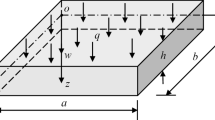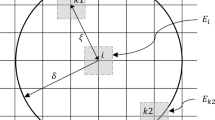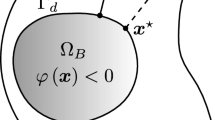Abstract
Quadrilateral finite elements for linear micropolar continuum theory are developed using linked interpolation. In order to satisfy convergence criteria, the newly presented finite elements are modified using the Petrov–Galerkin method in which different interpolation is used for the test and trial functions. The elements are tested through four numerical examples consisting of a set of patch tests, a cantilever beam in pure bending and a stress concentration problem and compared with the analytical solution and quadrilateral micropolar finite elements with standard Lagrangian interpolation. In the higher-order patch test, the performance of the first-order element is significantly improved. However, since the problems analysed are already describable with quadratic polynomials, the enhancement due to linked interpolation for higher-order elements could not be highlighted. All the presented elements also faithfully reproduce the micropolar effects in the stress concentration analysis, but the enhancement here is negligible with respect to standard Lagrangian elements, since the higher-order polynomials in this example are not needed.











Similar content being viewed by others
References
Nowacki, W.: Theory of Micropolar Elasticity. Springer, Vienna (1972)
Lakes, R.S.: Size effects and micromechanics of a porous solid. J. Mater. Sci. 18, 2572–2580 (1983). https://doi.org/10.1007/BF00547573
Lakes, R.S.: Reduced warp in torsion of reticulated foam due to Cosserat elasticity: experiment. Z. Angew. Math. Phys. 67, 46 (2016). https://doi.org/10.1007/s00033-016-0632-4
Diebels, S., Geringer, A.: Micromechanical and macromechanical modelling of foams: identification of Cosserat parameters. ZAMM J. Appl. Math. Mech./Z. Angew. Math. Mech. 94, 414–420 (2014). https://doi.org/10.1002/zamm.201200271
Eringen, A.C.: Microcontinuum Field Theories: I. Foundations and Solids. Springer, New York (2012)
Cosserat, E., Cosserat, F.: Théorie des corps déformables. Herman, Paris (1909), in French
Malvern, L.E.: Introduction to the Mechanics of a Continious Medium. Prentice-Hall Inc, New Jersey (1969)
Neuber, H.: On the General Solution of Linear-Elastic Problems in Isotropic and Anisotropic Cosserat Continua, pp. 153–158. Springer, Berlin (1966). https://doi.org/10.1007/978-3-662-29364-5_16
Toubal, L., Karama, M., Lorrain, B.: Stress concentration in a circular hole in composite plate. Compos. Struct. 68, 31–36 (2005). https://doi.org/10.1016/j.compstruct.2004.02.016
Dyszlewicz, J.: Micropolar Theory of Elasticity. Springer Science & Business Media (2004). https://doi.org/10.1007/978-3-540-45286-7
Eremeyev, V., Lebedev, L., Altenbach, H.: Foundations of Micropolar Mechanics. Springer, Berlin (2013). https://doi.org/10.1007/978-3-642-28353-6
Gauthier, R., Jahsman, W.E.: A quest for micropolar elastic constants. J. Appl. Mech. 42, 369–374 (1975). https://doi.org/10.1115/1.3423583
Yang, J.F.C., Lakes, R.S.: Transient study of couple stress effects in compact bone: torsion. J. Biomech. Eng. 103, 275–279 (1981). https://doi.org/10.1115/1.3138292
Yang, J.F.C., Lakes, R.S.: Experimental study of micropolar and couple stress elasticity in compact bone in bending. J. Biomech. 15, 91–98 (1982). https://doi.org/10.1016/0021-9290(82)90040-9
Lakes, R.S., Nakamura, S., Behiri, J.C., et al.: Fracture mechanics of bone with short cracks. J. Biomech. 23, 967–975 (1990). https://doi.org/10.1016/0021-9290(90)90311-P
Anderson, W.B., Lakes, R.S.: Size effects due to Cosserat elasticity and surface damage in closed-cell polymethacrylimide foam. J. Mater. Sci. 29, 6413–6419 (1994). https://doi.org/10.1007/BF00353997
Rueger, Z., Lakes, R.S.: Cosserat elasticity of negative Poisson’s ratio foam: experiment. Smart Mater. Struct. 25, 054004 (2016). https://doi.org/10.1088/0964-1726/25/5/054004
Lakes, R.S.: Experimental microelasticity of two porous solids. Int. J. Solids Struct. 22, 55–63 (1986). https://doi.org/10.1016/0020-7683(86)90103-4
Chen, C.P., Lakes, R.S.: Holographic study of conventional and negative Poisson’s ratio metallic foams: elasticity, yield and micro-deformation. J. Mater. Sci. 26, 5397–5402 (1991). https://doi.org/10.1007/BF02403936
Wang, X.L., Stronge, W.J.: Micropolar theory for two-dimensional stresses in elastic honeycomb. Proc. R. Soc. A Math. Phys. Eng. Sci. 455, 2091–2116 (1999). https://doi.org/10.1098/rspa.1999.0394
Mora, R.J., Waas, A.M., Arbor, A.: Evaluation of the micropolar elasticity constants for honeycombs. Acta Mech. 192, 1–16 (2007). https://doi.org/10.1007/s00707-007-0446-8
Duan, S., Weibin, W., Daining, F.: A predictive micropolar continuum model for a novel three-dimensional chiral lattice with size effect and tension-twist coupling behavior. J. Mech. Phys. Solids 121, 23–46 (2018). https://doi.org/10.1016/j.jmps.2018.07.016
Yoder, M., Thompson, L., Summers, J.: Size effects in lattice structures and a comparison to micropolar elasticity. Int. J. Solids Struct. 143, 245–261 (2018). https://doi.org/10.1016/j.ijsolstr.2018.03.013
Zhang, W., Neville, R., Zhang, D., et al.: The two-dimensional elasticity of a chiral hinge lattice metamaterial. Int. J. Solids Struct. 141–142, 254–263 (2018). https://doi.org/10.1016/j.ijsolstr.2018.02.027
Merkel, A., Luding, S.: Enhanced micropolar model for wave propagation in ordered granular materials. Int. J. Solids Struct. 106–107, 91–105 (2017). https://doi.org/10.1016/j.ijsolstr.2016.11.029
Niu, B., Yan, J.: A new micromechanical approach of micropolar continuum modeling for 2-D periodic cellular material. Acta Mech. Sin. 32, 456–468 (2016). https://doi.org/10.1007/s10409-015-0492-8
Romeo, M.: Surface waves in hexagonal micropolar dielectrics. Int. J. Solids Struct. 87, 39–47 (2016). https://doi.org/10.1016/j.ijsolstr.2016.02.235
Liebenstein, S., Zaiser, M.: Determining Cosserat constants of 2D cellular solids from beam models. Mater. Theory 2, 2 (2018). https://doi.org/10.1186/s41313-017-0009-x
Liebenstein, S., Sandfeld, S., Zaiser, M.: Size and disorder effects in elasticity of cellular structures: from discrete models to continuum representations. Int. J. Solids Struct. 146, 97–116 (2018). https://doi.org/10.1016/j.ijsolstr.2018.03.023
Bažant, Z., Christensen, M.: Analogy between micropolar continuum and grid frameworks under initial stress. Int. J. Solids Struct. 8, 327–346 (1972). https://doi.org/10.1016/0020-7683(72)90093-5
Besdo, D.: Towards a Cosserat-theory describing motion of an originally rectangular structure of blocks. Arch. Appl. Mech. 80, 25–45 (2010). https://doi.org/10.1007/s00419-009-0366-2
Hassanpour, S., Heppler, G.R.: Micropolar elasticity theory: a survey of linear isotropic equations, representative notations, and experimental investigations. Math. Mech. Solids 22, 224–242 (2015). https://doi.org/10.1177/1081286515581183
Grbčić, S., Ibrahimbegović, A., Jelenić, G.: Variational formulation of micropolar elasticity using 3D hexahedral finite-element interpolation with incompatible modes. Comput. Struct. 205, 1–14 (2018). https://doi.org/10.1016/j.compstruc.2018.04.005
Nakamura, S., Benedict, R., Lakes, R.: Finite element method for orthotropic micropolar elasticity. Int. J. Eng. Sci. 22, 319–330 (1984). https://doi.org/10.1016/0020-7225(84)90013-2
Providas, E., Kattis, M.A.: Finite element method in plane Cosserat elasticity. Comput. Struct. 80, 2059–2069 (2002). https://doi.org/10.1016/S0045-7949(02)00262-6
Li, L., Xie, S.: Finite element method for linear micropolar elasticity and numerical study of some scale effects phenomena in MEMS. Int. J. Mech. Sci. 46, 1571–1587 (2004). https://doi.org/10.1016/j.ijmecsci.2004.10.004
Zhang, H., Wang, H., Liu, G.: Quadrilateral isoparametric finite elements for plane elastic Cosserat bodies. Acta Mech. Sin. 21, 388–394 (2005). https://doi.org/10.1007/s10409-005-0041-y
Korepanov, V.V., Matveenko, V.P., Shardakov, I.N.: Finite element analysis of two- and three-dimensional static problems in the asymmetric theory of elasticity as a basis for the design of experiments. Acta Mech. 223, 1739–1750 (2012). https://doi.org/10.1007/s00707-012-0640-1
Wheel, M.A.: A control volume-based finite element method for plane micropolar elasticity. Int. J. Numer. Methods Eng. 75, 992–1006 (2008). https://doi.org/10.1002/nme.2293
Beveridge, A.J., Wheel, M.A., Nash, D.H.: A higher order control volume based finite element method to predict the deformation of heterogeneous materials. Comput. Struct. 129, 54–62 (2013). https://doi.org/10.1016/j.compstruc.2013.08.006
Hassanpour, S., Heppler, G.R.: Comprehensive and easy-to-use torsion and bending theories for micropolar beams. Int. J. Mech. Sci. 114, 71–87 (2016). https://doi.org/10.1016/j.ijmecsci.2016.05.007
Hassanpour, S., Heppler, G.R.: Theory of micropolar gyroeastic continua. Acta Mech. 227, 1469–1491 (2016). https://doi.org/10.1007/s00707-016-1573-x
Ma, T., Wang, Y., Yuan, L., et al.: Timoshenko beam model for chiral materials. Acta Mech. Sin. 34, 549–560 (2018). https://doi.org/10.1007/s10409-017-0735-y
Jelenić, G., Papa, E.: Exact solution of 3D Timoshenko beam problem using linked interpolation of arbitrary order. Arch. Appl. Mech. 81, 171–183 (2011). https://doi.org/10.1007/s00419-009-0403-1
Ribarić, D., Jelenić, G.: Higher-order linked interpolation in quadrilateral thick plate finite elements. Finite Elem. Anal. Des. 51, 67–80 (2012). https://doi.org/10.1016/j.finel.2011.10.003
Ribarić, D., Jelenić, G.: Higher-order linked interpolation in triangular thick plate finite elements. Eng. Comput. 31, 69–109 (2014). https://doi.org/10.1108/EC-03-2012-0056
Eringen, A.C.: Linear theory of micropolar elasticity. J. Math. Mech. 15, 909–923 (1966). https://doi.org/10.2307/24901442
Marsden, J.E., Hughes, T.J.R.: Mathematical Foundations of Elasticity. Dover Publications Inc., New York (1994)
Jeffreys, H.: On isotropic tensors. Math. Proc. Camb. Philos. Soc. 73, 173–176 (1973). https://doi.org/10.1017/S0305004100047587
Lakes, R.S.: Physical meaning of elastic constants in cosserat, void, and microstretch elasticity. Mech. Mater. Struct. 11, 1–13 (2016). https://doi.org/10.2140/jomms.2016.11.217
Cowin, S.C.: An incorrect inequality in micropolar elasticity theory. ZAMP, Z. Angew. Math. Phys. 21, 494–497 (1970). https://doi.org/10.1007/BF01627956
Tessler, A., Dong, S.: On a hierarchy of conforming Timoshenko beam elements. Comput. Struct. 14, 335–344 (1981). https://doi.org/10.1016/0045-7949(81)90017-1
Auricchio, F., Taylor, R.: A shear deformable plate element with an exact thin limit. Comput. Methods Appl. Mech. Eng. 118, 393–412 (1994). https://doi.org/10.1016/0045-7825(94)90009-4
Ibrahimbegović, A.: Nonlinear Solid Mechanics: Theoretical Formulations and Finite Element Solution Methods. Springer, London (2009)
Zienkiewicz, O.C., Taylor, R.L.: The Finite Element Method Volume 1: The Basis. Butterworth-Heinemann, Oxford (2000)
Taylor, R.: FEAP—Finite Element Analysis Program. University of California at Berkeley (2014). http://projects.ce.berkeley.edu/feap. Accessed 31 Jan 2019
Reddy, J.N.: An Introduction to the Finite Element Method, 2nd edn. McGrawHill Inc, Texas (1994)
Wilson, E.L., Ibrahimbegović, A.: Use of incompatible displacement modes for the calculation of element stiffnesses or stresses. Finite Elem. Anal. Des. 7, 229–241 (1990). https://doi.org/10.1016/0168-874X(90)90034-C
Grbčić, S.: Linked interpolation and strain invariance in finite-element modelling of micropolar continuum, [Ph.D. Thesis], University of Rijeka and Université de Technologie de Compiègne Sorbonne Universités (2018)
Bauer, S., Schäfer, M., Grammenoudis, P., et al.: Three-dimensional finite elements for large deformation micropolar elasticity. Comput. Methods Appl. Mech. Eng. 199, 2643–2654 (2010). https://doi.org/10.1016/j.cma.2010.05.002
Kirsch, E.: Die Theorie der Elastizität und die Bedürfnisse der Festigkeitslehre. Z. V. Dtsch. Ing. 42, 797–807 (1898), in German
Geuzaine, C., Remacle, J.-F.: Gmsh: a three-dimensional finite element mesh generator with built-in pre- and post-processing facilities. Int. J. Numer. Methods Eng. 79, 1309–1331 (2009). https://doi.org/10.1002/nme.2579
Nakamura, S., Lakes, R.S.: Finite element analysis of stress concentration around a blunt crack in a cosserat elastic solid. Comput. Methods Appl. Mech. Eng. 66, 257–266 (1988)
Acknowledgements
The research presented in this paper has been financially supported by the Croatian Science Foundation (Grants HRZZ-IP-11-2013-1631 and HRZZ-IP-2018-01-1732), Young Researchers’ Career Development—Training of Doctoral Students, as well as a French Government Scholarship.
Author information
Authors and Affiliations
Corresponding author
Appendix A: Shape functions
Appendix A: Shape functions
1.1 Appendix A.1: Quadrilateral finite elements
The shape functions in Eq. (34) are given for \(\xi _1=\xi _4=-1,~\xi _2=\xi _3=+1,~\eta _1=\eta _2=-1,~\eta _3=\eta _4=+1\) as follows, a being the node number according to Fig. 1. For Q4, they are defined as \(N_a(\xi ,\eta )=\frac{1}{4}(1+\xi _a \xi )(1+\eta _a \eta )\). For Q9, with \(\xi _8=-1\), \(\xi _5=\xi _7=\xi _9=0\), \(\xi _6=+1,~\eta _5=-1,~\eta _6=\eta _8=\eta _9=0\) and \(\eta _7=+1\), they are given as
while for Q16, with \(\xi _{11}=\xi _{12}=-1\), \(\xi _5=\xi _{10}=\xi _{13}=\xi _{16}=-\frac{1}{3}\), \(\xi _6=\xi _{9}=\xi _{14}=\xi _{15}=+\frac{1}{3}\), \(\xi _{7}=\xi _{8}=+1\), \(\eta _{5}=\eta _{6}=-1\), \(\eta _{7}=\eta _{12}=\eta _{13}=\eta _{14}=-\frac{1}{3}\), \(\eta _{8}=\eta _{11}=\eta _{15}=\eta _{16}=+\frac{1}{3}\) and \(\eta _{9}=\eta _{10}=+1\), they are given as
Rights and permissions
About this article
Cite this article
Grbčić, S., Jelenić, G. & Ribarić, D. Quadrilateral 2D linked-interpolation finite elements for micropolar continuum. Acta Mech. Sin. 35, 1001–1020 (2019). https://doi.org/10.1007/s10409-019-00870-1
Received:
Revised:
Accepted:
Published:
Issue Date:
DOI: https://doi.org/10.1007/s10409-019-00870-1




